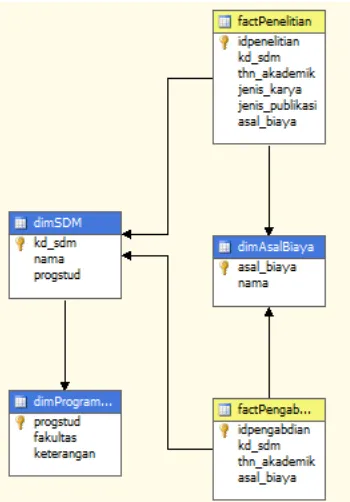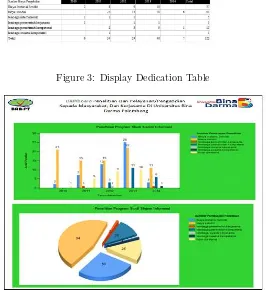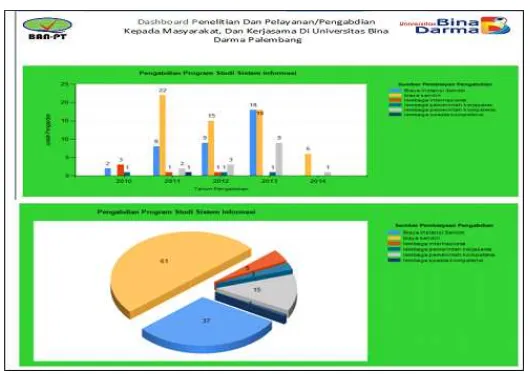The Recto
r’s
Greeting
Greetings and a warm welcome to the all academic researchers, practitioners,
industry and business person as well as policy makers. Thank you for attended this
4rd
international conference on Information
Technology
and
Engineering
Application 2016 (ICIBA 2016).
ICIBA is an annual event focusing on state of the art technologies pertaining to
digital information and communications and its application in business and industry
as well as government. The applications of advanced information technology to
such domains as networking, security, engineering, education, finance, geosciences,
health, transportation, supply chain management and logistics are among topics
of relevance to ICIBA. The conference features keynote speakers, the best student
award, poster award, technical open panel, and workshops/exhibits from industry,
government and academia as well postgraduate student colloquium.
All papers for the ICIBA 2016 on this Conference Proceeding (ISBN) was indexed
by EBSCO, Google Scholar, and sent to be reviewed by EiCompendex and ISI
Proceedings.
Our gratitude to all the participants who has take a part in this conference,
I hope we can take the advantage of academic research findings, to have better
insight about the importance of IT and business application, to the country
’s
economic development
Sincerely yours,
Prof. Ir. H. Bochari Rahman, M.Sc
PROCEEDING
INTERNATIONAL CONFERENCE ON INFORMATION TECHNOLOGY AND
ENGINEERING APPLICATION 2015
IT and Engineering for Better life
Published by:
Proceeding International Conference on Information Technology and
Engineering Application
Published by:
CONFERENCE COMMITTEE
Muhammad Izman Herdiansyah, PhD, Universitas Bina Darma, Indonesia
Erna Yuliwati, PhD, Universitas Bina Darma, Indonesia
Dr. Sunda Ariana, M.Pd., M.M. Universitas Bina Darma, Indonesia
Dr. Ahmad Syarifuddin, M.T., Universitas Bina Darma, Indonesia
Prof. Dr. Aizaini Maarof, Universiti Teknology Malaysia.
Prof. Dr. Wan Nasir, Universiti Teknology Malaysia.
Prof Dr. Eko Indrajit, Higher Education Association Information And
Computer Science (APTIKOM), Indonesia
Prof Zainal A Hasibuan, PhD, Higher Education Association Information
And Computer Science (APTIKOM), Indonesia
Dr. Paulus Sukapto, Ir., MBA, Universitas Katolik Parahyangan, Indonesia
Dr. Ir. T. Ari Samadhi, Institut Teknologi Bandung, Indonesia.
REVIEWER & EDITOR
Leon Andretti Abdillah
Darius Antoni
M. Izman Herdiansyah
Dedy Syamsuar
Edi Surya Negara
Support by. Bina Darma University Steering Committee ICIBA Cover Design by. Deni Erlansyah
CONTENTS
No
Titel
Page
INFORMATION TECHNOLOGY
1.
Application of 36 Cell Zachman Framework for Integrated
1 - 5
Spatial Planning Tax On Dinas Pendapatan Daerah
Kota Palembang
Paisal, M. Izman Herdiansyah, Afriyudi
2.
Design of Security Systems Cabin Car
6 - 14
From Danger Gas CO (Carbon Monoxide) With SMS
Gateway Information and Data Logger
Slamet Widodo, Ahyar Supani
3.
Implementation Felder Silverman Learning Style Model for
15 - 21
Content Support based on Ontology
in Indonesia Learning Management System
Bernard R. Suteja
4.
Steganography Application Bitwise Method of Encrypted
22 - 31
Message with Vigenere Cipher
Nazori Agani, Charles Victor B. Saragih, Chris Simon
5.
Vector Machine Learning Method for Text Mining Indonesian
32 - 37
Social Media Named Entity Recognition
Agus Suryana, Sri Ipnuwati
6.
Software Quality Assurance of Learning Game
38 - 45
Using Deutsch and Willis Method
Jumdapiokta, Sunda Ariana, Alex Wijaya
7.
Implementation Felder Silverman Learning Style Model for
46 - 54
Content Support based on Ontology
in Indonesia Learning Management System
Adelin, Muhammad Izman Herdiansyah, Afriyudi
8.
Characteristics of Users Website Kopertis II Palembang
55 - 60
Eka Hartati, Lin Yan Syah, Linda Atika
9.
Analysis of Factors Affecting the Use of Google Classroom
61 - 68
to Support Lectures
10. Enterprise Architecture Planning Design of Information
69 - 73
Systems Technology at PT Kreasi Utama Mandiri Using
Zachman Framework
Surahmat, Bochari Rahman, Yesi Novaria Kunang
11. Determining The Quality of Lecturer using Fuzzy
74 - 79
Simple Additive Weighting (SAW)
Satria Abadi, Sri Hartati, A. Humaidi
12. Application Location Based Service (LBS) Location Search
80 - 85
Palembang Nature-Based Android
Intan Okta Sari, Leon Andretti Abdillah, Kiky Rizky Nova
Wardhani
13. Extracted Social Network Mining
86 - 91
Mahyuddin K. M. Nasution
14. Information Systems Architecture Online Learning in School
92 - 98
with the Zachman Framework
Hatta Wijaya, M. Izman Herdiansyah, A. Haidar Mirza
15. Improved Models of Wireless Pricing Scheme in Multiple
99 - 104
Class QoS Networks by Determining the Base Price Value
Fitri Maya Puspita, Irmeilyana, Iffah Husniah
16. Diabetic Retinopathy Stages Classiffcation Using 3D-GLCM
105 - 112
Rocky Yefrenes Dillak, Sri Andayani
17. Comparison Route Redistribution on Dynamic Routing
113 - 119
Protocol (EIGRP into OSPF and EIGRP into IS-IS)
Chairul Mukmin, Darius Antoni, Edi Surya Negara
18. Nonlinear Programming Problem of Bandwidth Based and
120 - 126
VolumeBased Call Pricing Scheme in Wireless Networks
Fitri Maya Puspita, Kamaruzzaman Seman, Bachok M. Taib,
Ismail Abdullah
19. Survey Application for Telkomsel Customer Satisfaction
127 - 134
Lukman Sunardi, Nta Rosa Damayanti
20. Genetic Algorithms Method On Street Lighting Energy Saving
135 - 140
Jefri Lianda, Hikmatul Amri
21. The Implementation of Knowledge Management Systems
141 - 147
in Assets Reconciliation
22.
Performance Analysis for Migration Method IPv4 to IPv6
148 - 154Using Dual-Stack Technique
Aan Restu Mukti, Zainuddin Ismail, Edi Surya Negara
23.
Implementation of Business Intelligence Dashboard
155 - 161In Research, Service / Dedication To Society And Cooperation
Ahmad Kurniawan, Yesi Novaria Kunang, Susan Dian
Purnamasari
24.
Web Application Content News Aggregator on
162 - 167Communication Devices Based On Android
Merry Agustina, Usman Ependi
25.
Design and Development of a CAD Tool With Real Time
168 - 174Analysis for Dreadful Diseases
Dr.S.Asif Hussain, S.Jakeer Hussain, Edi Surya Negara
26.
Evaluation of Governance Maturity Level Sistem
Pembelajaran Online Dan Interaktif by Using Cobit 5 Framework
175 - 181Okti Firnawati, Darius Antoni, Diana
27.
Personal Financial Management Application Design
182 - 189Rusdiyanto
28.
Link Aggregation Analysis on MikroTik to Increase Throughput
190 - 197Bandwidth of Point to point Network
M. Agus Syamsul Arifin
29. Analysis of Transfer Rate Node Addition on
198 - 204
Mobile Ad Hoc Network (MANET) Infrastructure for File Server
Rudi Kurniawan
30.
Analysis of Effects of Application of E -learning activeness Against
Students In Learning Activity Using teaching Technology Acceptance
205 - 209Model (TAM)
( Studi Kasus : Sekolah Tinggi Teknologi Pagar Alam )
Sasmita
31.
Conceptual Framework Evaluation of Information Systems
210 - 216Badan Penyelenggara Jaminan Sosial (BPJS) Health In Palembang
Febriyanti Darnis, Darius Antoni, Linda Atika
32.
Efektivitas Penerapan Penerimaan Peserta Didik Baru (PPDB)
217 - 22133.
Development of Strategy Plan IS/IT In Urban Planning And
222 - 228Development Board of Palembang City : Literature Review
Serry Davizan, Zainuddin Ismail, Yesi Kunang
34. Identifying The Influencial Success Factors of
229 - 234
E-Government in Indonesia by Using Systematic Review
Alan Saputro, Darius Antoni, Muhamad Akbar
35.
Relationship Between The Application of Information Technology (IT)
And Its Effect On The Implementation
235 - 241of National Exam Success Computer-Based (UNBK)
(A Conceptual Framework)
Supriyadi, Darius Antoni, A. Haidar Mirza
36.
Evaluation of Application Of Information Technology
242 - 251Using Cobit Framework Model (Case Study Pt Bni Life Palembang)
Fahmi Ajismanto, Zainuddin Ismail, Widya Cholil
37.
Implementing IT Balanced Scorecard in Measuring
252 - 257System Performance : PT. Indah Logistic Cargo
Mardiana, Lin Yan Syah, Yesi Novaria Kunang
ENGINEERING APPLICATION
23. Design of Plastic Mulch Hole Maker to Decrease Work Load
258 - 263
and Increase Work Speed Strawberry Farmer in Bali
M. Yusuf, Nyoman Adiputra, I Dewa Putu Sutjana, Ketut
Tirtayasa
24.
Design of Baby Walking Assistant (AB3) by Using Axiomatic Design
Method
264 - 272
Dian Janari
25. Design Push Up DetectorUsing Quality Function Deployment
273 - 278
Method and Anthropometry
Ch Desi Kusmindari, Yanti Pasmawati, Ari Muzakir
279 - 283
26. Flow Pattern in the Estuary of Musi River Using MIKE-21 Flow Model
The 5th ICIBA 2016, International Conference on Information Technology and Engineering Application Palembang-Indonesia, 19-20 February 2016
Implementation of Business Intelligence Dashboard
In Research, Service / Dedication To Society
And Cooperation
Ahmad Kurniawan, Yesi Novaria Kunang,
Susan Dian Purnamasari
Ilmu Komputer, Universitas Bina Darma Jalan Ahmad Yani No.3, Plaju, Palembang
e-mail: [email protected], [email protected], [email protected]
Abstract
Accreditation of department is an education quality measuring standard, such as recognition ondepartment in university for showing about department in university has fulfilled standard or requirement which is assigned by Badan Akreditasi Na-sional Perguruan TInggi (BAN-PT). Accreditation of department has seven stan-dards which one of standard is research, service / dedication to society and co-operation by lecturer and student. Those reasons make University of Bina Darma evaluate, monitor, and fulfill requirement on 7thstandard. One of solution which can be implemented is business intelligence dashboard.Business intelligence dashboard is an application which has function for collecting, analyzing, saving, and providing re-quired data in organization or company into knowledge, then be used for supporting decision and planning. Business intelligence dashboard is going to be implemented to report of accreditation of department in the University of Bina Darma in accor-dance with 7thstandard. On these business intelligence dashboards, University of Bina Darmacan fill 7thstandard efficiently and correctly.
Keywords : Accreditation of department, BAN-PT, Dashboard, Business intelligence and7th standard
1 INTRODUCTION
So rapidly development ofuniversity in Indonesia, make government set a university ed-ucation quality standard, where kind of universities are state university, official university, religious university and private university. These standards become reference and benchmark of quality of university education, called accreditation.
156
a process,performance and correlation with goal, input, process and output from university or department, that are responsible with each university and department. That accreditation is accreditation of department that always do every 5 years.
Research and service / dedication to society, and cooperation is seventh item that is evaluated by BAN-PT. This standard is a reference of education quality, service / dedication to society and cooperation that is organized and related to develop department. University of Bina Darma has borang team that has job for fulfilling criteria that is set on 7thstandard. Items that are evaluated on 7thstandard are department, lecturer, source of research fund and dedication fund, research and dedication of lecturer in the last three years.
After all of items were getting, team started to do data collecting process. Those data are collected in excel form. Team started to do selecting process, evaluating, and calculating that based onstandard 7th and is set on BAN-PT. Amount of big data that are processed, can be able error in arranging 7thstandard. This condition always held up performance of team. Whereas those activities are carried out periodically every five years. Therefore, it needed a technology that can help team correctly and efficiently, then reduce error in arranging accreditation.
One of technology can be used for helping those problems is business intelligence. Business intelligence is a system that has function for collecting, analyzing, saving and facilitating data that are needed an organization or company in knowledge form, then are used for supporting decision and planning. With those power, business intelligence can help borang team.
2 RESEARCH METHODOLOGY
Methods are used in this research is business intelligence roadmap[3]. According to Larisa T.Mosss book, business intelligence is divided into analysis method and design method [3].
2.1 Analysis Method
Analysis method that is used consist of seven steps, among others
1. Justification
Business Case Assessment For designing a business intelligence application, first step that must be done is determine, check or evaluate and collect needed information, such as goal, strategic and aim an organization.
2. Planning
This step has two main activities that are done, they are enterprise infrastructure evaluation and project planning.
(a) Enterprise Infrastructure
Evaluation Infrastructure Design that is done is for BI application can run well. This step consists of Technical Infrastructure and non-technical infrastructure.
(b) Project Planning
This step is created for design of application that can finish on time.
157
This step has four main activities, they are project requirement definition, data analysis, application prototyping and metadata repository analysis.
(a) Project Requirement Definition
This step is evaluating of available infrastructure, what they are appropriate with needed infrastructure or not.
(b) Data analysis
This step is evaluating of quality of data, what they are good quality or not.
(c) Application Prototyping
This created feature designs that base on needed company, then application is created appropriately with features that are agreed or negotiated in prototype form
(d) Metadata Repository Analysis
Metadata is designed for saving company contextual information.
2.2 Design Method
According to Larissa T.Mosss book, design method that was used, consisted of seven steps, among others[3] :
1. Design
(a) Database design
Database design is done for supporting application that is built with creating star schema or snowflake schema.
(b) ETL design
This step is done if those data are bad quality. Yet, if data are good quality, so this step does not need to be done.
(c) Metadata repository design
This step is done for designing of repository metadata. This is for showing source of database that are used.
2. Construction
(a) ETL Development
This step described about process of drawing ETLthat was done in creating busi-ness intelligence dashboard. This step will do if data are bad quality, and this step wont do if data are good quality.
(b) Application Development
This step is creating business intelligence dashboard and result of output or display from that application.
(c) Data Mining
158
(d) Metadata Repository Development This step showed display from each metadata repository that were created before in project that based on result of information. Metadata repository consists of OLAPs data.
3 THEORETICAL BASIC
3.1 Dashboard
There are several kind of dashboard, according to Rasmussen, Bansal and Chen put forward three types of dashboard[4], among others :
1. Strategic Dashboard
Strategic dashboard is used for supporting management of strategic level that give in-formation and make business decision, predict chance and give guidance of achievement of strategic goal.
2. Tactical Dashboard
This dashboard focus on analysis process for determining factor that caused a condition or event.
3. Operational Dashboard
Operational dashboard has function as supporting and monitoring activities of specific business process.This focus on monitoring activities.
4 RESULT
Explainning from result of dashboards that are created, among others:
1. Data were taken from sources where data were saved in MySQL database. Those data consisted of 3 tables, factPenelitian table, factPengabdian table and dimSDM table. FactPenelitian table consisted of 1662 data, factPengabdian consisted of 1321 data and dimSDM table consisted of 275 data. Those tables were imported to SQL Server database with using SQL Server Integration Service (SSIS). In SSIS, this also created dimAsalBiaya table from factPenelitian or factPengabdian table, and dimProgramStudi table was from dimSDM. dimAsalBiaya consisted of 8 data and dimProgramStudi con-sist of 19 data.
2. Those tables were cleaned in SQL Server Integration Service (SSIS).
3. Then those tables were analyzed in SSAS (SQL Server AnalysisService). This step had goal for creating OLAP (Online Analytical Processing). In this step, it consisted of cube and dimension. Cubes consisted of two cubes, penelitian cube and pengabdian cube, whereas dimensions consisted of AsalBiaya, SDM, Penelitian and Pengabdian dimension. If there was attribute that was showed, so it can be added that attribute in data source view to available dimension. it can be seen at picture 1.
159
Figure 1: Display Cube
penelitian dashboard and pengabdian dashboard.As for result of dashboard display, it can be seen at picture 2,3,4 and 5:
5. Result of dashboards that were created, were deployed to reporting server with sub-mitting target of server url. This target was http://localhost/ReportServer. Url was run on Internet Explorer.
Figure 2: Display Research Table
5 CONCLUSION
Conclusion that can be got from this research, among others:
con-160
Figure 3: Display Dedication Table
Figure 4: Display penelitian Dashboard
tain matrix and table that can help borang team in monitoring research and dedication of lecturer, and giving informations accurately to borang team about lecturer research data and lecturer dedication data in the last five years, accordance with 7thstandard, that eased teams job and efficiently time.
2. Business intelligencedashboard that were created, consisted of penelitian table, pengab-dian table, penelitian dashboard and pengabpengab-diandashboardeach department in Univer-sity of Bina Darma.
3. Business intelligence dashboard in research, service or dedication and cooperation with lecturer and student of University of Bina Darma, gave information about mount of research and dedication of lecturer department during the last five years.
161
Figure 5: Display Pengabdian Dashboard
References
[2] Badan Akreditasi Nasional Perguruan Tinggi (2009),Buku I Naskah Akademik Akreditasi Program Studi Sarjana, BAN-PT: Jakarta.
[2] Badan Akreditasi Nasional Perguruan Tinggi (2009), Buku II Standar dan Prosedur Akreditasi Program Studi Sarjana, BAN-PT: Jakarta.
[3] Larissa T.Moss, Shaku Atre (2008).Business Intelligence Roadmap-The Complete project lifecycle for Decision-Support Applications.
[4] Rasmussen, Bansal, Chen (2009),Business Dashboards: A Visual Catalog for Design and Development, John Wiley & Sons: New Jersey.


